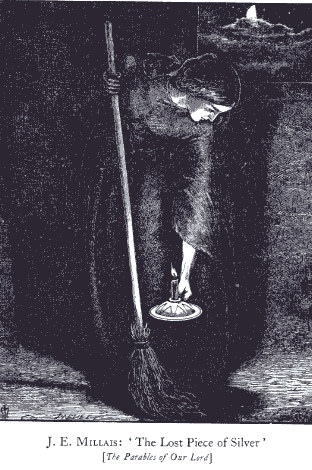La Vendée
 John Everett Millais, from Forrest Reid, Illustrators of the Eighteen Sixties1
John Everett Millais, from Forrest Reid, Illustrators of the Eighteen Sixties1
In September of the year 2000 a group of us on Trollope-l read La Vendée together. Each week I wrote an essay or essays in the form
of postings to Trollope-l on the chapters we had read for that week.
Most of mine are close readings of the text; some are about Trollope's
sources and attitudes; others discuss the nature of historical fiction.
Then the conversation begins to emerge and moves back and forth on all
sorts of things: character, scenes, personal impulses when we read. I
have included many postings by other members as I could find and
threaded them in according to a date or where they seemed to make
sense. Contributors include: Roger Batt, Sigmund Eisner, Judy
Geater, Wayne Gisslen, Mark Jensen, R. J. Keefe,
Kristi Larsen, Richard Mintz, John Mize, Angela Richardson, Gene
Stratton, Dagny Wilson, Robert Wright, Todd Yelrom.
Volume I
- Introduction: Background, Sources, Editions, RMullen, Counter-Revolution
- Chapters 1-5: Scene Settting, Character Portraits, The Initiation
of the Revolt; Other Novels of the Period on this Counter-Revolution
- Chapters 6-10: The Interlace: The Political and War Story; the
Love and Human Interest Stories, Church Facades and the French
Landscape
Volume II
- Chapters 11-15: Scenes of War, The Presence of Walter Scott, The
Private Impinged upon by Public Events: The Moving Death of
Cathelineau, Family Conflicts
- Chapters 16-20: The Social Meanings of War, Trollope the Conservative, RBolt's A Man for All
Seasons, BBrecht, "A Worker Reads History"; The World-Historical Figures in the Novel,
Trollope and Scott, Trollope and Sterne, Prejudiced "Introductions", Denot the Most Moving
Character in the Book
Volume III
- Chapters 21-25: Robespierre, More Trollope and Scott, Trollope's Politics; The Private Realm and the Women;
Trollope's Identification with Cathelineau & Denot
- Chapters 26-30: The Finest Chapters of the Book; The One Sexually Seen Loving Married Couple in all Trollopes
(the Lescures); The Soldier's Angry Mother; "What Good Has the War Done?"
- Chapters 31-35: Denot Again; Large canvas, Small figures, or Trollope's Denot in a Scott-like landscape; Denot
as a Type Found Often in Trollope (e.g., Crawley, the Misfit, Louis Trevelyan, both labelled
"insane"); And How to Achieve a Happy Ending -- Jump Forward to a Moment where all seems
Propitious and Stop There, or It's Just a Matter of Pulling Down the Curtain 22 and then again 35
Years On, Nothing Simpler
1 The reproduction is a detail from a drawing whose caption is "The Lost Piece of Silver"; the picture belongs to Millais's series, The Parables of Our Lord. I find it beautiful and appropriate to a story focusing on country people in rural France.
Home
Contact Ellen Moody.
Pagemaster: Jim
Moody.
Page Last Updated 4 February 2004

